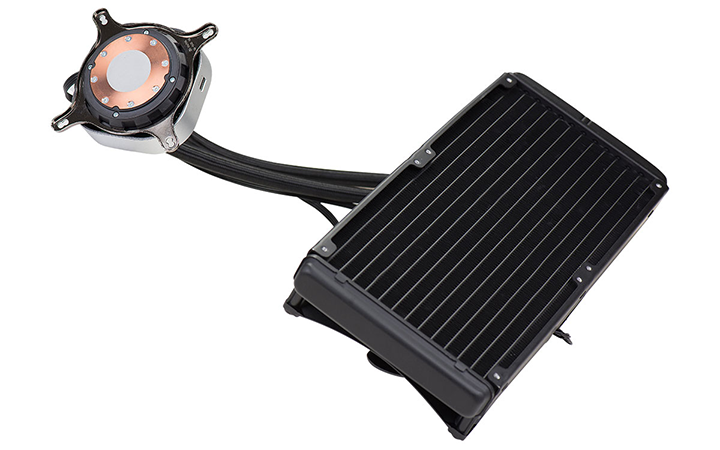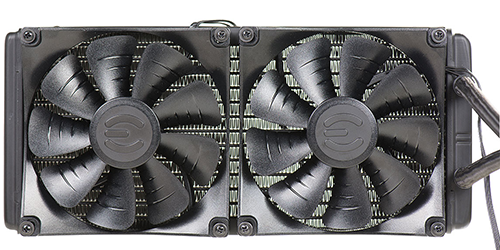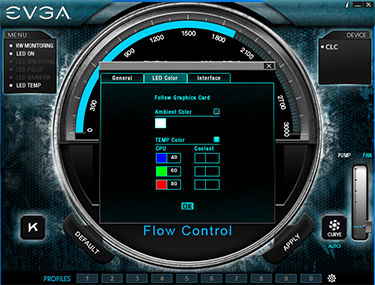Introduction
It is easy to see why so many manufacturers want a slice of the liquid-cooling pie. Producing all-in-one products shouldn't be difficult - simply choose an OEM and add a few customisations to apply your own stamp - and hey presto, you've a premium product with plenty of enthusiast appeal.
But not all liquid coolers are alike, as the manufacturer-specific tweaks range from RGB lighting, additional software and tailor-made fans. EVGA has all this and more in its latest offering, the CLC 280.
Priced at £130 and aimed at the enthusiast who doesn't want to dabble with a custom loop, this closed-loop-cooler (CLC) is designed to be easy to install and powerful enough to tame an overclocked CPU. Radiator dimensions of 312mm x 139mm x 27mm limit chassis compatibility somewhat, but if you have room for the aluminium block, an all-in-one cooler helps clear the clutter from around the CPU socket, creating a tidy-looking build.
Build quality, as you'd expect from an Asetek-based cooler, is good throughout, but given EVGA's prominence in the graphics market, we're a tad surprised the firm has opted for a completely sealed unit. This is strictly a CPU-only solution and no provisions have been made for incorporating a graphics card into the loop.
Sleeved tubing neatly connects the radiator to the pump and copper waterblock, with the latter supplied with a neat coat of thermal paste as standard. Do note that no additional thermal paste is provided as part of the bundle, so you'll need to source your own supply for any subsequent installations.
The bundle does include fixtures and fittings for Intel sockets LGA2011, 2011-v3, 1150, 1151, 1155, 1156 and 1356, as well as AMD AM2, AM3, FM1 and FM2. Support for AMD Ryzen (AM4) isn't available out of the box, but a compatible bracket can be ordered free of charge.
In an effort to stand out from the crowd, EVGA equips the radiator with two 140mm Teflon Nano Bearing fans. Both are pre-attached to the radiator in an intake configuration (though they can be reversed if need be) and the unusual 'curved housing' is said to improve airflow and limit vibration.
At the other end of the product, the low-profile CPU block, with neatly rounded sides, touts a transparent top with a backlit EVGA logo. The RGB illumination can be configured by the user and be set to respond to temperature or match an EVGA graphics card, however the position of the tubing is likely to obscure the illumination - the pipework naturally droops down, somewhat defeating the purpose the of the lights.
Asetek's latest-generation mounting kit worked well on the recently reviewed Fractal Design Celsius S24, and it's the same story here. Fix the plastic backplate to the rear of the motherboard using the supplied standoffs, then secure the CPU block in place with the four metal bolts.
Installation could hardly get any easier, though, if you're being picky, you could argue that EVGA's implementation isn't the cleanest. Both fans attach to a split cable emanating from the top of the block, and the three-pin power cable originates from the same position. In addition to these two cables, a USB lead connects to the bottom of the block and attaches to a motherboard header for software customisation. Something to be aware of if keeping cable clutter down to a minimum is high on your list of priorities.
Software control tends to divide consumers. Some prefer not to install additional utilities for components that ought to just work, while others appreciate the ability to fine-tune. EVGA is targeting the latter crowd with its Flow Control software, through which both the RGB LED and the fan curve can be customised.
Flow Control doesn't scale well on our 4K screen and the software still feels rough around the edges. What's interesting is that fan speed doesn't drop below 1,000rpm at the lowest setting and the default fan curve is particularly aggressive. The only way to reduce noise further is to manually lower the voltage supplied to the three-pin header via BIOS, though in doing so you risk stalling both the pump and fans. EVGA is clearly focussed on performance first and foremost, so let's see what the benchmarks have to say.
















